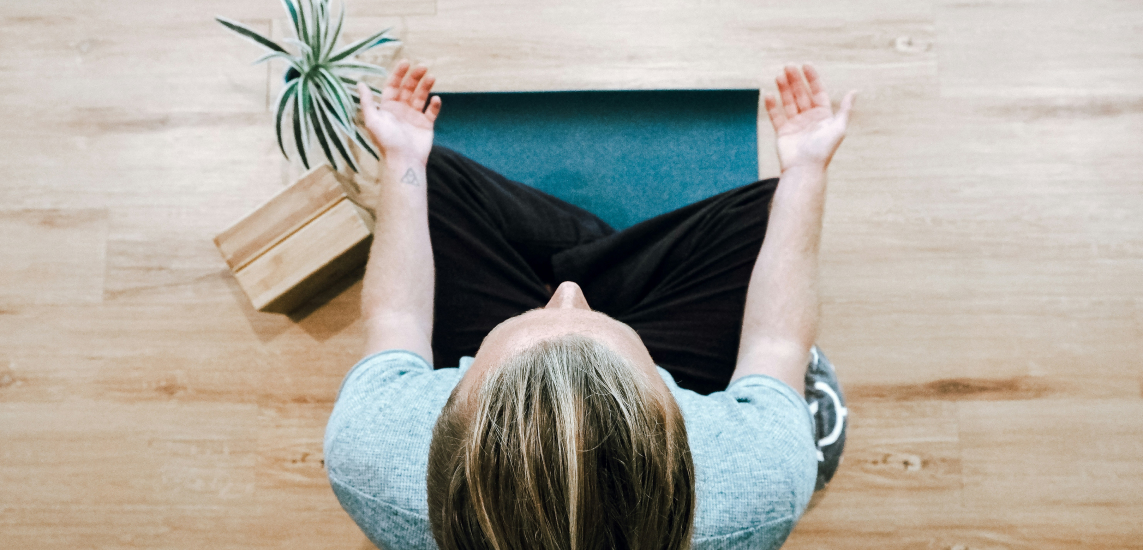Yoga nidra, meaning “yogic sleep,” can not only help you obtain deep rest and relaxation but may also guide you into a peaceful slumber — potentially mid-yoga nidra session or mid-class. You might jolt awake with a twinge of guilt or embarrassment. However, there’s no shame here. With yoga nidra, sleep is only natural.
But if you’re still not convinced, we’ve gone the extra mile, asking yoga teacher Jennifer Piercy about using yoga nidra for sleep and whether or not it’s okay to fall asleep during a yoga nidra meditation. Below, we explore the benefits of yoga nidra, how it works, and whether or not you should try to combat sleep during this yoga practice.
Key takeaways
- Yoga nidra is a meditative practice guiding individuals into a state of consciousness between being awake and asleep.
- If your goal with yoga nidra is to obtain better sleep, you don’t need to worry about falling asleep during a session or yoga class.
- If you intend to practice yoga nidra for enhanced awareness or spiritual growth, however, falling asleep may not be in your best interest.
- Embrace yoga nidra with Insight Timer and select a guided yoga nidra session from thousands of options that match your interests and intentions.
What is yoga nidra?
Yoga nidra is a deeply restorative and meditative practice that places individuals into a state of consciousness between wakefulness and sleeping. It takes the body out of the fight-or-flight state and into the rest-and-digest mode, activating the brain waves associated with a deep state of relaxation. In particular, this yoga practice is highly beneficial for those who struggle with sleep or stress.
The practice of yoga nidra has roots in ancient India. However, according to researchers, the modern form of yoga nidra as a guided meditation practice, was popularized by Swami Satyananda Saraswati in the mid-20th century. Saraswati developed a systematic approach to the technique based on his extensive study of yoga and tantra.
A guided yoga nidra session typically involves:
- Lying down in corpse pose (savasana) on a mat or comfortable surface
- Setting an intention (sankalpa)
- Performing a body scan
- Focusing on your breathing
Modern yoga nidra encompasses a variety of techniques, including:
- Pratyahara: This refers to the turning of one’s attention inward, letting go of external sensory distractions.
- Body scans: When performing a body scan, you tense part of your body, then systematically release that tension.
- Breath awareness and pranayama: To bring your attention further inward, you focus on each inhale and exhale.
- Visualization: This involves visualizing certain scenarios or specific images.
- Integration of opposites: Your instructor may have you focus on feelings that are opposite of one another. For example, the heaviness of your limbs followed by the feeling of lightness in those same body parts.
How does yoga nidra work?
With yoga nidra meaning yogic sleep, it’s no surprise this meditative practice places the mind and body in a deeply relaxed state. By focusing on different parts of our bodies and our breathing, yoga nidra activates our parasympathetic nervous system. This slows our breathing and heart rate and decreases stress hormones. Research even suggests yoga nidra helps reduce blood pressure.
From these effects, yoga nidra has various benefits, including stress reduction, improved mental well-being, better sleep quality, enhanced focus, and spiritual growth.
Is it okay to fall asleep during yoga nidra?
To answer this question, we turned to Jennifer Piercy, who has vast knowledge and expertise in yoga nidra. Her voice has led millions of people on Insight Timer into a deep yoga nidra experience.
So, is it okay to fall asleep? Piercy says, “Personally, I would never tell someone they ‘should not’ necessarily fall asleep in yoga nidra.”
Yoga nidra can often mean falling asleep. In fact, many people use it for this very reason. Piercy adds, “Nidra, the Sanskrit word for sleep, has many possible meanings. Its roots are Ni — which means nothingness, empty, void, dissolution — and Dru — which means to draw forth from within. So, we could say nidra means ‘to draw emptiness forth from within.’ Nidra has also been used to describe the act of sleeping or falling asleep. It has also been used to represent the disappearing of ‘the mind’ or all ‘attention.’ It’s been used to refer to sleep with or without dreams, as well as total awareness in deep sleep, the dream state, OR wakefulness.”
“Yoga nidra is about awareness — not clinging to waking,” says Piercy. “True yoga nidra doesn’t require that ‘I’ be ‘awake’ in the usual way of perceiving wakefulness. It’s an exploration of Awareness, which is the backdrop in which all other possible waves of consciousness swim and is unbreakable, always present.”
Therefore, if sleep calls to you during your practice, it might be a sign that that is exactly what you need.
- Yoga Nidra For Sleep Jennifer Piercy 22:21
- Bone Deep Sleep Jennifer Piercy 15:07
- Yoga Nidra: Freedom Nature Jennifer Piercy 30:14
- Yoga Nidra: Melatonin Magic Jennifer Piercy 19:44
Why does yoga nidra make me sleepy?
Many individuals opt to use yoga nidra as a relaxation technique and a form of guided sleep meditation. And there are many reasons yoga nidra can place us in a deep sleep. Here are a few.
Reduces stress
Studies show that yoga nidra reduces the stress hormones within our bodies. For many, stress can be a major hurdle when it comes to obtaining a peaceful night’s sleep. Research has even found yoga nidra improves sleep for those with chronic insomnia. Thus, performing a yoga nidra session before bedtime can eliminate stress and guide your body into the rest-and-digest state for better sleep.
In addition, other studies indicate that yoga nidra increases heart rate variability, a key marker of reduced stress levels. Yoga nidra isn’t just for bedtime — it’s also a great tool to use during the day when your stress levels are heightened.
Decreases pain
Research shows that yoga nidra meditations helped reduce acute pain better than relaxing music. It’s also been put forth as a potential avenue for managing chronic pain. Yoga nidra can help individuals struggling to sleep due to chronic pain ease into a restful sleep.
Leads to deep relaxation
While you might not necessarily fall asleep during every yoga nidra session, it’s undeniable that it leads to enhanced relaxation. With reduced stress and pain, you can activate the parasympathetic nervous system (the rest-and-digest system) much easier.
We can even consider this deep relaxation as a different type of sleep. Jennifer Piercy states, “Just as there is more than one kind of yoga, there is more than one kind of sleep. There are layers and levels to this thing we call sleep… micro and macro, biologically, personally, and culturally. Sleep isn’t ‘just losing consciousness’ — sleep is part of consciousness. When people say yoga nidra isn’t ‘just ordinary sleep,’ I see it not as a blanket rejection of sleep itself within the practice but rather the culture’s myopic view of sleep — which tends to be shallow, mechanical, and generally problematic, contributing to the rise of sleep challenges rather than helping ease them.”
Embrace this relaxed state of consciousness during your yoga nidra sessions and use Insight Timer to deepen your practice further. With 200,000+ tracks and 18,000 teachers to choose from, you can personalize your journey toward improved sleep and stress relief. Download the Insight Timer app today.
Other benefits of yoga nidra
Beyond sleep and relaxation, yoga nidra has many other benefits, including:
- Improved mental health
- Enhanced focus and clarity
- Emotional healing
- Spiritual growth
- Self-discovery
- Improved awareness
At the end of the day, yoga nidra helps us connect with our inner selves and mute external distractions. It guides us toward a newfound state of consciousness that isn’t easily accessible in our busy daily lives.
When to practice yoga nidra
Yoga nidra can be practiced at any time. The only time of the day it’s not recommended is shortly after eating as your body is busy digesting, and sleep or deep relaxation can significantly slow this process down.
It’s worth noting that if your intention with yoga nidra goes beyond relaxation, such as gaining greater awareness, falling asleep during a session may not be in your best interest. In this case, performing yoga nidra during the day (instead of close to bedtime) is best.
For all others, you can integrate yoga nidra as part of your regular meditation practice first thing in the morning or before you go to bed. Insight Timer offers countless yoga nidra sessions to choose from. With a few clicks, you can practice yoga nidra anywhere and any time.
Resources and tools for yoga nidra
Insight Timer’s free meditation app
Insight Timer’s goal is to offer global access to meditation for anyone who wishes to reap the benefits. As such, the majority of the content on our meditation app is free. With over 200,000 tracks and 80+ new ones added daily, Insight Timer can support your meditative journey. Choose from guided and unguided meditations for a personalized path toward improved mental health and well-being.
Online resources and communities
Discover communities of like-minded individuals on Insight Timer to take your yoga nidra journey to the next level. You can find thousands of others on similar paths to yours and gain valuable knowledge and support.
FAQ about yoga nidra for sleep
Is it okay to take a yoga nidra nap?
Yes. If sleep calls to you during your yoga nidra session, there’s no need to fight it. However, the one downside is that you may wake up groggy after falling asleep.
Can yoga nidra replace actual sleep?
No, yoga nidra can’t replace actual sleep. Sleep is necessary for the deep restoration of the body and its processes. While yoga nidra can’t replace it entirely, it can help you obtain better sleep by guiding you toward a deeper relaxation state.
How long should a yoga nidra session last for effective results?
Usually, yoga nidra sessions last from 30 to 60 minutes. This length of time is often necessary to achieve profound relaxation and activate the brain waves associated with the rest-and-digest state.
How often should you practice yoga nidra for best results?
This depends on your personal preferences. You can practice yoga nidra daily to truly reap its stress-reducing and sleep-enhancing effects, or you can use it as needed. For daily practices, consider using Insight Timer to guide you.
How much sleep is yoga nidra equivalent to?
While some may claim that a 60-minute yoga nidra session equals four hours of sleep, yoga nidra should never replace sleep entirely. However, yoga nidra can activate comparable brain waves, giving way to similar rejuvenation and rest associated with deep sleep.
References
Datta, K., Tripathi, M., Verma, M., Masiwal, D., & Mallick, H. N. (2021). Yoga nidra practice shows improvement in sleep in patients with chronic insomnia: A randomized controlled trial. The National medical journal of India, 34(3), 143–150. https://doi.org/10.25259/NMJI_63_19
Devraj, J. P., Santosh Kumar, B., Raja Sriswan, M., Jagdish, B., Priya, B. S., Neelu, S. B., Desai Rao, V., Kumar, M., Geddam, J. J. B., & Hemalatha, R. (2021). Effect of Yoganidra on Blood Pressure, Hs-CRP, and Lipid Profile of Hypertensive Subjects: A Pilot Study. Evidence-based complementary and alternative medicine : eCAM, 2021, 2858235. https://doi.org/10.1155/2021/2858235
Ferreira-Vorkapic, C., Borba-Pinheiro, C. J., Marchioro, M., & Santana, D. (2018). The Impact of Yoga Nidra and Seated Meditation on the Mental Health of College Professors. International journal of yoga, 11(3), 215–223. https://doi.org/10.4103/ijoy.IJOY_57_17
Hapidou, E. G., & Huang, T. Q. A. (2022). East Meets West in Therapeutic Approaches to the Management of Chronic Pain. International journal of yoga, 15(1), 70–75. https://doi.org/10.4103/ijoy.ijoy_104_21
Li, L., Shu, W., Li, Z., Liu, Q., Wang, H., Feng, B., & Ouyang, Y. Q. (2019). Using Yoga Nidra Recordings for Pain Management in Patients Undergoing Colonoscopy. Pain management nursing : official journal of the American Society of Pain Management Nurses, 20(1), 39–46. https://doi.org/10.1016/j.pmn.2018.04.005
Markil, N., Whitehurst, M., Jacobs, P. L., & Zoeller, R. F. (2012). Yoga Nidra relaxation increases heart rate variability and is unaffected by a prior bout of Hatha yoga. Journal of alternative and complementary medicine (New York, N.Y.), 18(10), 953–958. https://doi.org/10.1089/acm.2011.0331
Moszeik, E., Von Oertzen, T., & Renner, K. (2020). Effectiveness of a short Yoga Nidra meditation on stress, sleep, and well-being in a large and diverse sample. Current Psychology, 41(8), 5272–5286. https://doi.org/10.1007/s12144-020-01042-2
Pandi-Perumal, S. R., Spence, D. W., Srivastava, N., Kanchibhotla, D., Kumar, K., Sharma, G. S., Gupta, R., & Batmanabane, G. (2022). The Origin and Clinical Relevance of Yoga Nidra. Sleep and vigilance, 6(1), 61–84. https://doi.org/10.1007/s41782-022-00202-7
Vaishnav, B., Vaishnav, S., Vaishnav, V., & Varma, J. (2018). Effect of yoga-nidra on adolescents well-being: A mixed method study. International Journal of Yoga/International Journal of Yoga, 11(3), 245. https://doi.org/10.4103/ijoy.ijoy_39_17







-1.jpg)
